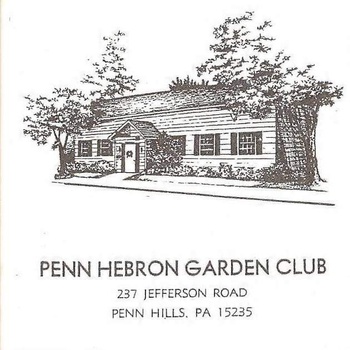
The Penn Hebron Garden Club building, also known as the Morrow barn building, is a 178 year-old structure and historic landmark located at 237 Jefferson Rd. in the heart of Penn Hills.* The barn was constructed in 1834 of hand-hewn virgin oak, on the Morrow Family Farm, which covered some 340 acres known as the Flying Shuttle.
In 1921, a group of women organized the Allegheny County Unit of the National Farm and Garden Association. Not only did these 14 women set about beautifying their community by planting flowers and shrubs around public buildings, they sold their produce, eggs and handicrafts and held benefits in order to fulfill their dream of having a clubhouse.
In 1928, the women bought the old barn, which was nearly 100 years old then, and set to converting it into their permanent meeting space. Around that time, the membership changed the name of its organization to The Penn Hebron Garden Club.
There was much cleanup. The wagon wheels, oxen yokes and old lanterns found in the barn were converted into the light fixtures you can see upstairs today. The animal stalls and barn floor became the kitchen and dining area. The loft was converted into the present upstairs ballroom. Mrs. H. S. (Ella) Morrow served as the club’s first president. Her photograph can still be seen to the left of the stage. The stage was subsequently added to the ballroom, so that entertainment could be incorporated into the club’s fundraising efforts. For decades, the members of the Penn Hebron Garden Club staged original plays, held music concerts and flower shows, along with community benefits. In keeping with the Club’s mission, several churches were allowed to build their congregations at the clubhouse before they were able to construct their own home buildings. St. Bartholomew’s and Zion Lutheran are two such examples.
The Morrow Barn is home to many historic documents and photos which evince both the club’s rich history while mirroring that of Penn Hills itself. In these records, we can learn that the financing for the purchase of the barn began with only 12 pennies. The mortgage was fully paid in 1936 and was commemorated with a festive note burning celebration. Most prominently, on June 8, 1975 the club celebrated the acquisition of the plaque that designates the clubhouse as a historical landmark as recognized by the Pittsburgh Historical Landmarks Society.
*Thanks and full credit to the members of the Penn Hebron Garden Club for selected historical text. In particular, Mrs. Harry S. Morrow, a history written by Ruby Faulkner Woods (1975) was used as source material.

Juneteenth is the oldest nationally celebrated commemoration of the ending of slavery in the United States. And the longest-running African American holiday. Dating back to 1865, it was on June 19th that the Union soldiers, led by Major General Gordon Granger, landed at Galveston, Texas with news that the war had ended and that the enslaved were now free. Note that this was two and a half years after President Lincoln’s Emancipation Proclamation - which had become official January 1, 1863. The Emancipation Proclamation had little impact on the Texans due to the minimal number of Union troops to enforce the new Executive Order. However, with the surrender of General Lee in April of 1865, and the arrival of General Granger’s regiment, the forces were finally strong enough to influence and overcome the resistance.
Later attempts to explain this two and a half year delay in the receipt of this important news have yielded several versions that have been handed down through the years. Often told is the story of a messenger who was murdered on his way to Texas with the news of freedom. Another is that the news was deliberately withheld by the enslavers to maintain the labor force on the plantations. And still another is that federal troops actually waited for the slave owners to reap the benefits of one last cotton harvest before going to Texas to enforce the Emancipation Proclamation. All of which, or none of these versions could be true. Certainly, for some, President Lincoln's authority over the rebellious states was in question. Whatever the reasons, conditions in Texas remained status quo well beyond what was statutory.
One of General Granger’s first orders of business was to read to the people of Texas, General Order Number 3 which began most significantly with:
"The people of Texas are informed that in accordance with a Proclamation from the Executive of the United States, all slaves are free. This involves an absolute equality of rights and rights of property between former masters and slaves, and the connection heretofore existing between them becomes that between employer and hired laborer."
The reactions to this profound news ranged from pure shock to immediate jubilation. While many lingered to learn of this new employer to employee relationship, many left before these offers were completely off the lips of their former 'masters' - attesting to the varying conditions on the plantations and the realization of freedom. Even with nowhere to go, many felt that leaving the plantation would be their first grasp of freedom. North was a logical destination and for many it represented true freedom, while the desire to reach family members in neighboring states drove some into Louisiana, Arkansas and Oklahoma. Settling into these new areas as free men and women brought on new realities and the challenges of establishing a heretofore non-existent status for black people in America. Recounting the memories of that great day in June of 1865 and its festivities would serve as motivation as well as a release from the growing pressures encountered in their new territories. The celebration of June 19th was coined "Juneteenth" and grew with more participation from descendants. The Juneteenth celebration was a time for reassuring each other, for praying and for gathering remaining family members. Juneteenth continued to be highly revered in Texas decades later, with many former slaves and descendants making an annual pilgrimage back to Galveston on this date.
Today, Juneteenth is enjoying a phenomenal growth rate within communities and organizations throughout the country. Institutions such as the Smithsonian, the Henry Ford Museum and others have begun sponsoring Juneteenth-centered activities. In recent years, a number of local and national Juneteenth organizations have arisen to take their place along side older organizations - all with the mission to promote and cultivate knowledge and appreciation of African American history and culture.
Juneteenth today, celebrates African American freedom and achievement, while encouraging continuous self-development and respect for all cultures. As it takes on a more national, symbolic and even global perspective, the events of 1865 in Texas are not forgotten, for all of the roots tie back to this fertile soil from which a national day of pride is growing.
The future of Juneteenth looks bright as the number of cities and states creating Juneteenth committees continues to increase. Respect and appreciation for all of our differences grow out of exposure and working together. Getting involved and supporting Juneteenth celebrations creates new bonds of friendship and understanding among us. This indeed brightens our future - and that is the Spirit of Juneteenth.